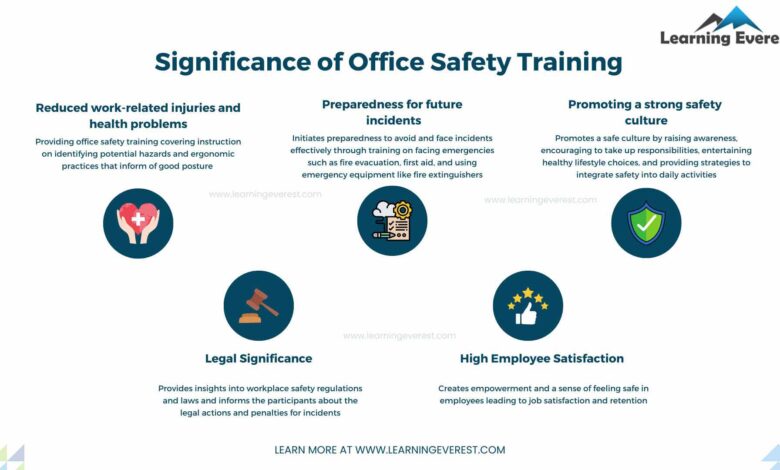Incorporating Office Safety Training for Employee Wellbeing

This blog discusses the definition of office safety training, its significance, and strategies to incorporate office safety training in an organization.
Office Safety Training: Definition
A significant factor that attracts and retains employees in an organization is workplace safety. The initial step toward ensuring safety is to provide office safety training at all levels to educate the employees to recognize possible threats and adopt measures to overcome them. Office safety training is a structured training program designed to instruct employees about the knowledge, skills, and practices to be implemented for a safe and secure work environment. The training equips the participants with instructions and guidelines for recognizing emergency incidents, reporting them, and effective handling of such situations. With a broad range of topics including emergency response procedures to cybersecurity and data protection, the training intends to promote a healthy workplace.
Office Safety Training: Significance
A safe, compliant, and productive work environment is the most crucial aspect that employees consider relevant for an organization. This is achieved by incorporating office safety training that informs employees of the risks and ways to overcome them. The alarming rates of hazards and health-related issues affecting employees point to the significance of adopting office safety training. Here are the reasons why the training is significant.


Significance of Office Safety Training
Reduced work-related injuries and health problems
Regardless of the differences in the nature of work, employees face different health issues and work-related injuries at their organization. Studies reveal that “7 million people suffer from workplace injuries each year in the United States.” (Source: GMS, 2024). The injuries can be from accidents like falls or slips, handling equipment, or hazards. The potential health issues that affect the performance of employees are repetitive strain and discomfort, issues with vision and hearing, musculoskeletal issues, and mental health concerns. Providing office safety training covering instruction on identifying potential hazards and ergonomic practices that inform of good posture contributes to a healthier workforce.
Preparedness for future incidents
Office safety training prepares participants to be prepared to avoid and face future incidents effectively. According to the Workplace Safety Statistics by AlertMedia, “83% of employees have encountered an emergency at work.” This calls for getting trained in facing emergencies such as fire evacuation, first aid, and using emergency equipment like fire extinguishers. The training empowers the participants to respond quickly avoiding panic in situations thereby protecting themselves and others from the hazards.
Promoting a strong safety culture
A strong safety culture in an organization ensures safety as a core value and shared responsibility. Office safety training promotes a safe culture and supports overall well-being by raising awareness, encouraging to take up responsibilities, entertaining healthy lifestyle choices, and providing strategies to integrate safety into daily activities.
Legal Significance
Along with the organizational significance, providing office safety training has legal significance. The training provides insights into workplace safety regulations and laws and informs the participants about the legal actions and penalties for incidents. It is legally mandatory that organizations must educate their employees on safety and security and steps to be taken during emergencies.
High employee satisfaction
Office Safety training contributes to employee morale and satisfaction ultimately leading to enhanced organizational productivity. Data suggests that there is a “6% increase in employee morale and job satisfaction for businesses that use workplace safety programs” and “43% increased productivity from employees who follow workplace safety programs.” (Source: GMS). The training creates empowerment and a sense of feeling safe in employees leading to job satisfaction and retention.
Office Safety Training: Strategies to incorporate in workplace
Organizations should incorporate office safety training by adopting strategies to enhance the understanding, practical application, and retention of the topics. The strategies should focus on promoting a secure work environment and a strong safety culture. For a high-outcome training program, trainers can follow the following strategies:
Address all the key areas
Ensure that the training covers all the key areas related to office safety such as fire safety, first aid, handling equipment, hazard identification and reporting, mental health and stress, office security, cybersecurity, etc. When providing training divide into different courses and modules for each of these topics and integrate multiple training approaches to engage the participants. For instance, role plays and demonstrations can be effective in providing training on first aid and hazard identification.
Educate on the safety statement
An office safety statement is a document that projects the policies and practices in an organization to maintain a healthy workplace. The training that focuses on safety statements not only informs employees of the procedures but also creates awareness of the necessary steps to be taken in each situation. One crucial method to inform the participants about the safety statement is scenario-based learning to show the practical application of the statement in different situations. In addition, the trainers can employ infographics to provide visual knowledge of the statement.
Inform the ergonomic principles
Ergonomics is “the process of designing or arranging workplaces, products, and systems so that they fit the people who use them”. (Source: Dohrmann Consulting. Organizations can offer training to their employees on the key principles of ergonomics by providing interactive lessons on setting up an ergonomically optimized workplace and maintaining correct posture. The training can also include checklists for self-assessments where participants can reflect on their habits, and collect feedback and follow-up surveys from employees to make necessary alterations in the workplace.
Offer job-specific training
In addition to providing general safety training, organizations can opt for training on specific roles to address the unique risks and hazards associated with the job. The trainers can analyze the hazards associated with a role and custom content based on it. For example, training on electrical safety for technical staff and effective document handling for administrative staff. Instructors can make use of different training delivery methods to ensure the efficiency of the program.
Conclusion
There is a wide range of risks that can be encountered by employees in an organization. Office safety training is designed to instruct employees about the knowledge, skills, and practices to be implemented for a safe and secure work environment and equip the participants with instructions and guidelines for recognizing emergency incidents, reporting them, and effectively handling such situations. It is important to incorporate this training as it paves the way to reduce work-related injuries and health problems, prepares the employees to avoid and face future incidents, promotes a strong safety culture, possesses legal significance, and leads to high employee satisfaction.
When implementing office safety training in organizations, trainers can adopt strategies such as addressing all key areas, educating on the safety statement, informing the ergonomic principles, and offering job-specific training. The training can be conducted employing diverse training delivery methods and splitting up the relevant areas into different courses and modules to enhance the learning. It is advisable that organizations adopt significant strategies to enlighten their employees through safety training and employees should identify the importance of attaining the training and the necessity to perform the learning in critical times.
Infographic


Strategies to Incorporate Office Safety Training
Knowledge Check!
Frequently Asked Questions (FAQs)
What is office safety training?
Office safety training is a structured training program designed to instruct employees about the knowledge, skills, and practices to be implemented for a safe and secure work environment.
What are the areas in office safety training?
The key areas related to office safety are fire safety, first aid, handling equipment, hazard identification and reporting, mental health and stress, office security, cybersecurity, etc.
What is ergonomics?
“Ergonomics is the process of designing or arranging workplaces, products, and systems so that they fit the people who use them.”
Why is office safety training important?
It is important to incorporate this training as it paves the way to reduce work-related injuries and health problems, prepares the employees to avoid and face future incidents, promotes a strong safety culture, possesses legal significance, and leads to high employee satisfaction.



